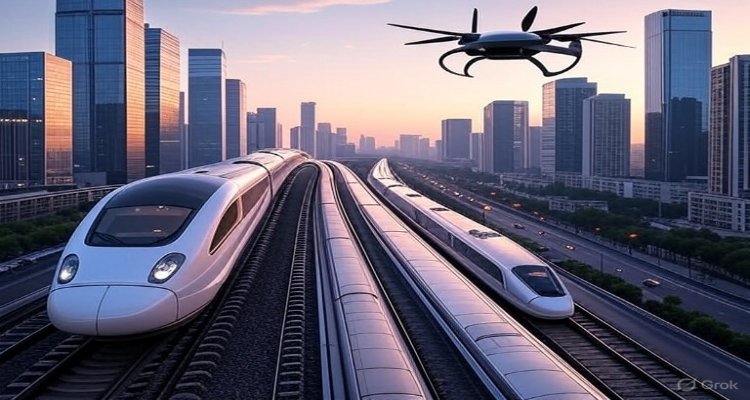The Future of Travel Without Airports
The future of travel may move beyond airports, driven by high-speed rail, hyperloop, and urban air mobility. Discover what comes next for global mobility
Introduction: A New Horizon for Mobility
Imagine a world where long security lines, delayed boarding, and sprawling terminals are relics of the past. For decades, airports have acted as gateways to global connectivity, but the next era of travel may challenge their very necessity. With new technologies and shifting priorities in sustainability, convenience, and efficiency, the once unshakable role of airports in human movement is now under question. Could we be heading into a future where airports become optional — or even obsolete?
Context & Background
Airports have historically been the backbone of international and domestic travel. They evolved from modest airstrips into mega-cities complete with shopping complexes, hotels, and entertainment hubs. Yet, despite modernization, airports remain synonymous with long waiting times, logistical bottlenecks, and heavy carbon footprints.
Meanwhile, innovations in transportation are rewriting the rules of mobility. High-speed rail networks in Asia and Europe now rival—and in many cases surpass—short-haul flights in efficiency and convenience. Emerging technologies such as urban air mobility (UAM), hyperloop prototypes, and autonomous aviation concepts are pushing the boundaries of point-to-point travel, making bypassing airports not only possible but increasingly practical.
Main Developments: The Technologies Replacing Airports
Several key developments are at the forefront of redefining what travel could look like in a world without traditional airports.
-
High-Speed Rail Expansion: Countries like China, France, and Japan have demonstrated that high-speed trains can whisk travelers across hundreds of kilometers in less time than it takes to fly when airport wait times are factored in. In 2025, China’s high-speed rail network surpassed 45,000 kilometers in length, transforming regional movement.
-
Hyperloop Systems: Once a futuristic concept, Hyperloop technology—capsules moving through vacuum tubes at speeds nearing 1,000 km/h—is steadily gaining momentum with pilot testing projects underway in Europe, the Middle East, and the U.S. A successful rollout would render many short-haul flights unnecessary.
-
Urban Air Mobility (UAM): Electric Vertical Take-Off and Landing (eVTOL) aircraft, championed by companies like Joby Aviation and Lilium, aim to transform city-to-city and intra-urban connectivity. Unlike conventional planes, these crafts require minimal infrastructure, operating from vertiports instead of massive terminals.
-
Autonomous Aviation: Advances in drone technology and AI-driven aviation are opening doors to smaller, distributed hubs closer to cities. Instead of massive airports in suburban sprawl, future travelers may use compact hubs located within urban landscapes.
-
Digital Connectivity & Remote Presence: In some cases, “travel” itself could be redefined. With next-generation AR, VR, and holographic conferencing, the need for business travel could decline drastically, further reducing dependence on airports.
Expert Insight & Public Reaction
Industry experts believe the 21st century represents a turning point in travel infrastructure.
Transportation analyst Priya Mehra commented, “Within the next two decades, we may see a future where airports serve fewer people. Major hubs will still exist for long-haul journeys, but everyday mobility might bypass them entirely.”
Public sentiment often favors alternatives to airports, particularly among younger generations who prioritize both convenience and sustainability. A survey by the International Transport Forum in 2024 found that 68% of respondents favored high-speed rail over short-haul flights when both options were available. Social media discourse amplifies this, with travelers frequently lamenting long airport waits and calling for more direct, local forms of travel.
Impact & Implications
If travel without airports becomes mainstream, the effects will be disruptive and wide-reaching:
-
Economic Impact: Airport revenues relying on retail, parking, and airline partnerships could decline. City planners may need to rethink how urban landscapes integrate mobility.
-
Environmental Benefits: Phasing out short-haul flights in favor of rail or eVTOL could dramatically cut carbon emissions.
-
Accessibility: Smaller hubs and direct travel methods could bring global connectivity closer to communities without major airports.
-
Industry Shifts: Airlines may transition toward different business models, adapting fleets for alternative air mobility or partnering with high-speed rail networks.
While airports will not disappear entirely—they remain crucial for intercontinental journeys—their dominance as travel’s essential gateway could diminish, reshaping both travel habits and global infrastructure.
Conclusion: A World Beyond Terminals
The future of travel without airports is no longer science fiction. From high-speed rail corridors to hyperloop systems and eVTOL flights, the traditional airport is losing its monopoly on global connectivity. As technology, urban planning, and sustainability goals converge, travelers may soon enjoy a system where mobility is faster, greener, and far more decentralized. Airports will still exist, but the triumph of new transport modes could redefine them from necessities into options — relics of a world where convenience lagged behind possibility.
Disclaimer : This article is for informational purposes only. The projections and expert insights are based on available data as of 2025 and should not be considered as financial or investment advice.











